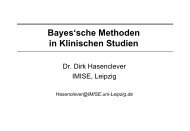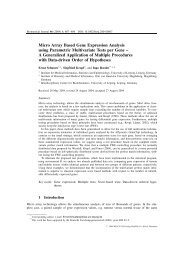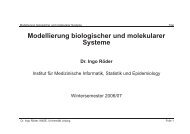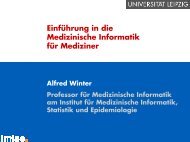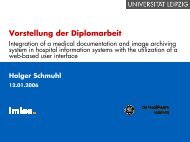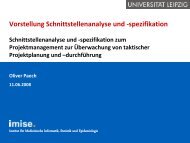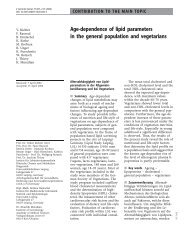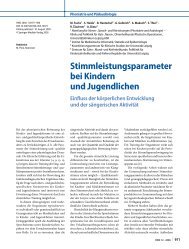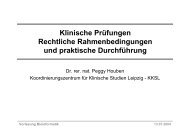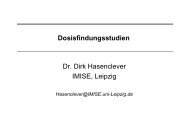Entropy Inference and the James-Stein Estimator, with Application to ...
Entropy Inference and the James-Stein Estimator, with Application to ...
Entropy Inference and the James-Stein Estimator, with Application to ...
Create successful ePaper yourself
Turn your PDF publications into a flip-book with our unique Google optimized e-Paper software.
HAUSSER AND STRIMMER<br />
The true cell probabilities θ 1 ,...,θ 1000 were assigned in four different fashions, corresponding <strong>to</strong><br />
rows 1-4 in Figure 1:<br />
1. Sparse <strong>and</strong> heterogeneous, following a Dirichlet distribution <strong>with</strong> parameter a = 0.0007,<br />
2. R<strong>and</strong>om <strong>and</strong> homogeneous, following a Dirichlet distribution <strong>with</strong> parameter a = 1,<br />
3. As in scenario 2, but <strong>with</strong> half of <strong>the</strong> cells containing structural zeros, <strong>and</strong><br />
4. Following a Zipf-type power law.<br />
For each sampling scenario <strong>and</strong> sample size, we conducted 1000 simulation runs. In each run, we<br />
generated a new set of true cell frequencies <strong>and</strong> subsequently sampled observed counts y k from <strong>the</strong><br />
corresponding multinomial distribution. The resulting counts y k were <strong>the</strong>n supplied <strong>to</strong> <strong>the</strong> various<br />
entropy <strong>and</strong> cell frequencies estima<strong>to</strong>rs <strong>and</strong> <strong>the</strong> squared error ∑ 1000<br />
i=k (θ k − ˆθ k ) 2 was computed. From<br />
<strong>the</strong> 1000 repetitions we estimated <strong>the</strong> mean squared error (MSE) of <strong>the</strong> cell frequencies by averaging<br />
over <strong>the</strong> individual squared errors (except for <strong>the</strong> NSB, Miller-Madow, <strong>and</strong> Chao-Shen estima<strong>to</strong>rs).<br />
Similarly, we computed estimates of MSE <strong>and</strong> bias of <strong>the</strong> inferred entropies.<br />
4.2 Summary of Results from Simulations<br />
Figure 1 displays <strong>the</strong> results of <strong>the</strong> simulation study, which can be summarized as follows:<br />
• Unsurprisingly, all estima<strong>to</strong>rs perform well when <strong>the</strong> sample size is large.<br />
• The maximum likelihood <strong>and</strong> Miller-Madow estima<strong>to</strong>rs perform worst, except for scenario 1.<br />
Note that <strong>the</strong>se estima<strong>to</strong>rs are inappropriate even for moderately large sample sizes. Fur<strong>the</strong>rmore,<br />
<strong>the</strong> bias correction of <strong>the</strong> Miller-Madow estima<strong>to</strong>r is not particularly effective.<br />
• The minimax <strong>and</strong> 1/p Bayesian estima<strong>to</strong>rs tend <strong>to</strong> perform slightly better than maximum<br />
likelihood, but not by much.<br />
• The Bayesian estima<strong>to</strong>rs <strong>with</strong> pseudocounts 1/2 <strong>and</strong> 1 perform very well even for small sample<br />
sizes in <strong>the</strong> scenarios 2 <strong>and</strong> 3. However, <strong>the</strong>y are less efficient in scenario 4, <strong>and</strong> completely<br />
fail in scenario 1.<br />
• Hence, <strong>the</strong> Bayesian estima<strong>to</strong>rs can perform better or worse than <strong>the</strong> ML estima<strong>to</strong>r, depending<br />
on <strong>the</strong> choice of <strong>the</strong> prior <strong>and</strong> on <strong>the</strong> sampling scenario.<br />
• The NSB, <strong>the</strong> Chao-Shen <strong>and</strong> <strong>the</strong> shrinkage estima<strong>to</strong>r all are statistically very efficient <strong>with</strong><br />
small MSEs in all four scenarios, regardless of sample size.<br />
• The NSB <strong>and</strong> Chao-Shen estima<strong>to</strong>rs are nearly unbiased in scenario 3.<br />
The three <strong>to</strong>p-performing estima<strong>to</strong>rs are <strong>the</strong> NSB, <strong>the</strong> Chao-Shen <strong>and</strong> <strong>the</strong> prosed shrinkage estima<strong>to</strong>r.<br />
When it comes <strong>to</strong> estimating <strong>the</strong> entropy, <strong>the</strong>se estima<strong>to</strong>rs can be considered identical for<br />
practical purposes. However, <strong>the</strong> shrinkage estima<strong>to</strong>r is <strong>the</strong> only one that simultaneously estimates<br />
cell frequencies suitable for use <strong>with</strong> <strong>the</strong> Shannon entropy formula (Equation 1), <strong>and</strong> it does so<br />
<strong>with</strong> high accuracy even for small samples. In comparison, <strong>the</strong> NSB estima<strong>to</strong>r is by far <strong>the</strong> slowest<br />
method: in our simulations, <strong>the</strong> shrinkage estima<strong>to</strong>r was faster by a fac<strong>to</strong>r of 1000.<br />
1474



